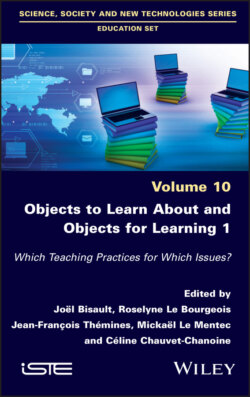Читать книгу Objects to Learn about and Objects for Learning 1 - Группа авторов - Страница 14
Part 2 of Volume 2 – Objects and Traces of the Activity
ОглавлениеPart 2 of Volume 2 deals with various objects (assessments, technical objects, school objects) and their activation by subjects. The contributions in this part are based on a variety of theoretical and analytical frameworks, which do, however, have the common point of studying the way in which material or symbolic objects become usable objects as soon as they enter into a relationship with the user. The relationship between the subject and the object thus reveals unique experiences and activities, which differ according to the contexts studied, and these traces must be recorded. This part consists of three research reports and a testimony.
With regard to the research aspect, Sylvie Grubert Jost’s contribution (Chapter 6) focuses on the practice of self-assessment of the skills expected in elementary school as a learning object and a shared responsibility between pupil and teacher. The author shows how assessment becomes a communication object as soon as it enters into a relationship with the subject who uses it. Communication between the teacher and the pupil around the practice of self-assessment then becomes a means of making the two parties jointly responsible for learning and for better perceiving each other’s expectations. The contribution of John Didier, Marion Botella, Rachel Attanasio and Marie-Dominique Lambert (Chapter 7) analyzes the process of creation of a technical object by elementary school pupils, paying particular attention to the different stages that lead them to this creation, whether reflective, decisional or linked to action. The objective of this research is to analyze the process of transforming recycled materials to enable the creation of a sound garden and to analyze what the pupils take away from it in terms of learning throughout the process. Chapter 8, by Corinne Marlot, Christine Riat and Patrick Roy, examines the methods of entry into scientific culture for elementary cycle 1 pupils. More specifically, the authors analyze the conditions under which a school discipline object (in this case, a collective poster) can foster the institution of scientific practices in these pupils. The results show that scientific acculturation – as a means of learning about and understanding the world – involves thinking about the nature of the material, symbolic and language objects that can be mobilized, their relationship and also the way in which they should be introduced in order to engage pupils intellectually. This part concludes with the testimony of Irene Guevara, Iván Moreno-Llanos, Lucía Romero, Laura Zapardiel and Cintia Rodríguez (Chapter 9) who examine the self-regulatory practices of children below 3 years of age by analyzing their actions on objects and instruments around them. The authors show that children control their behavior and actions long before they have consolidated verbal language. Their actions on objects arise from understanding the phenomena but also from the solutions and strategies envisaged to understand what must be done and how. They also underline the role of the teacher and the challenges they impose on them to foster the development of the child.
Thus, these four contributions analyze the way in which material or symbolic objects enter into a relationship with subjects, their activation and what the subjects take away from them in terms of learning or development from the moment they think about them, handle them or transform them.
